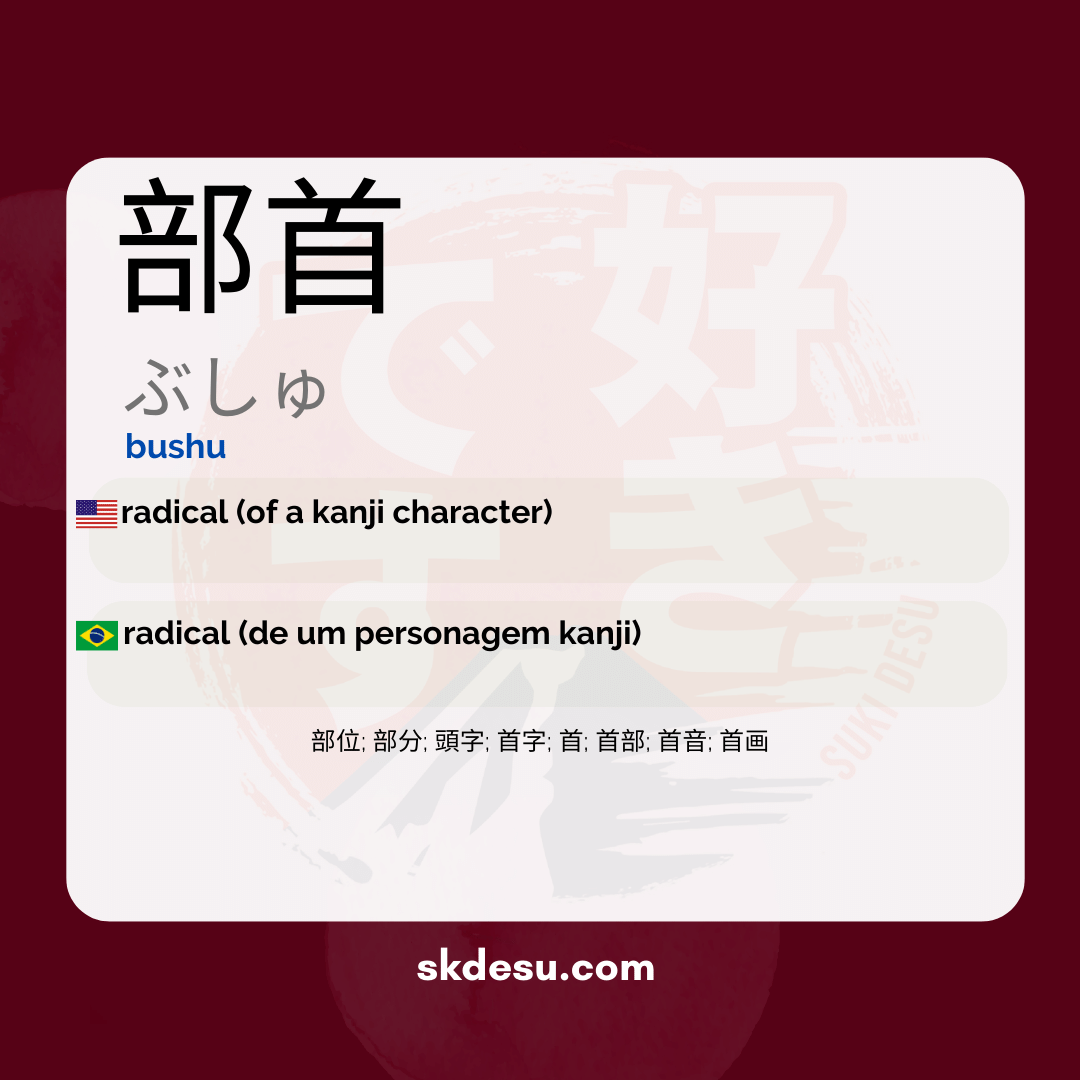Translation and Meaning of: 部首 - bushu
The term 「部首」 (bushu) refers to the radicals of kanji characters, one of the writing systems used in the Japanese language. This word is composed of two kanji: 「部」 (bu), which means "section" or "part," and 「首」 (shu), which means "head" or "first." The combination of these two characters reflects the idea that radicals are the "main parts" or "heads" of kanji, serving as a key to understanding and categorizing the more than two thousand characters used in modern Japanese.
Historically, the origin of radicals dates back to ancient China, where they were initially established to systematize Chinese writing. The first dictionaries of Chinese characters, such as the famous "Shuowen Jiezi", used radicals to organize the characters in a logical and accessible way. This method of categorization was later adopted and adapted by the Japanese writing system with the introduction of kanji in Japan during the early centuries of the Common Era.
In the study of kanji, being able to identify the radicals is essential, as they often provide a clue about the meaning or pronunciation of a character. Radicals not only assist in the memorization and learning of kanji but also are useful in consulting dictionaries. For example, if you know that a kanji belongs to the "water" radical, you can infer that its meaning has some relation to liquids or the aquatic environment.
In addition to their practical functions, many scholars and enthusiasts of the Japanese language enjoy exploring the stories and the evolution of kanji and their radicals. This interest often leads to a deeper understanding of Japan’s culture and history. Thus, while the radicals may seem like a small part of the vast universe of kanji, they are, in fact, fundamental to unraveling the Japanese writing system and its rich cultural heritage.
Vocabulary
Expand your vocabulary with related words:
Synonyms and similar words
- 部位 (bui) - Specific part of a body or object, usually used in a medical context.
- 部分 (bubun) - Part or section of a whole, without specification of type.
- 頭字 (とうじ, touji) - Initial letter or first letter of a word.
- 首字 (しゅじ, shuji) - Initial letter, frequently related to the beginning of a text or title.
- 首 (くび, kubi) - Collar or neck, but also used in expressions to indicate leadership.
- 首部 (しゅぶ, shubu) - Part or initial section of a text or document.
- 首音 (しゅおん, shuon) - Sound or initial pronunciation, often used in phonetics.
- 首画 (しゅが, shuga) - Initial stroke of a kanji or letter.
Related words
Romaji: bushu
Kana: ぶしゅ
Type: noun
L: jlpt-n2
Translation / Meaning: radical (of a kanji character)
Meaning in English: radical (of a kanji character)
Definition: The strokes and shapes that are the constituent elements of kanji characters.
Quick Access
- Vocabulary
- Writing
- Sentences
How to Write in Japanese - (部首) bushu
See below a step-by-step guide on how to write the word by hand in Japanese. (部首) bushu:
Example Sentences - (部首) bushu
See below some example sentences:
Bushu wa kanji no kōsei yōso o hyō shimasu
Bushu represents the structural elements of kanji.
The radical represents the components of Kanji.
- 部首 - means "radical" in Japanese and is used to classify kanji (Japanese ideograms) according to their features and components.
- は - topic marking particle, which indicates that what comes next is the subject of the sentence.
- 漢字 - means "Chinese characters" and refers to the ideograms that were imported from China and adapted into the Japanese language.
- の - possession particle, which indicates that what follows is the possessor or constituent of the object.
- 構成要素 - means "constituent elements" and refers to the strokes and components that make up kanji.
- を - direct object particle, which indicates that what follows is the direct object of the sentence.
- 表します - means "represents" and is the verb that indicates the action that the radicals perform when composing the kanji.
Other Words of this Type: noun
See other words from our dictionary that are also: noun

